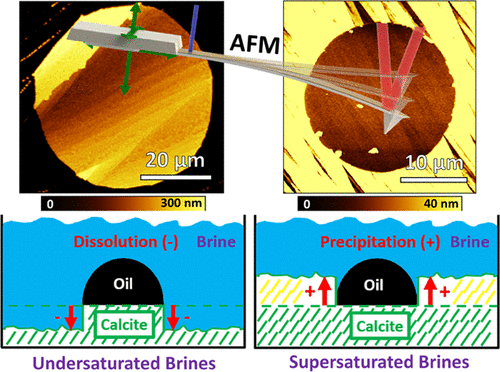Abstract Microscopic Characterization of Mineral Dissolution and Precipitation at Variable Salinity for Improved Oil Recovery in Carbonate Reservoirs

Aging of carbonate mineral surfaces in brines of variable salinity and crude oil leads to massive transformations of surface topography and chemical composition including the formation of mixed organic–inorganic interfacial layers. The response of these interfacial layers to variations in brine composition is responsible for local (chemical) wettability alteration and therefore becomes the main microscopic driver for improved oil recovery in low-salinity water flooding or SmartWater flooding. In this study, a new method was developed to directly visualize local nanoscale dissolution and (re)precipitation around the three-phase contact line on model calcite surfaces in the presence of crude oil and ambient brine upon aging. The sessile microscopic oil drops on calcite surfaces were exposed to brines of variable composition at room temperature (22 °C) and at elevated temperatures (95 °C) for up to 2 weeks. Brines ranged from hypersaline formation water to diluted high-salinity water, in part enriched with Mg2+ or SO42– ions. In situ optical and ex situ atomic force microscopy (AFM) imaging of the calcite surfaces was performed prior to and after aging, complemented by confocal Raman imaging. Optical images show that crude oil drops remained attached to the mineral surfaces throughout all aging procedures studied and displayed only occasional minor relaxations of their shape at elevated temperatures. Ex situ AFM images after calcite cleaning and drying displayed strong marks of the original droplet positions that appeared either as holes or as protruding mesas with respect to the surrounding surface level, with height differences up to several hundred nanometers. The sessile oil drops are thus found to protect the underlying calcite surface from both precipitation and dissolution, in overall agreement with the macroscopic calcite saturation of the brines. The qualitative trends are consistent for all conditions investigated, notwithstanding a higher degree of variability at elevated temperatures and upon preaging in oil-equilibrated formation water. In contrast to the calcite–brine interface that undergoes these massive transformations, the oil–calcite interface remains overall remarkably inert. Only at 95 °C does the occasional appearance of roundish rims accompanied by hillocks suggest the growth of water drops during aging, possibly via exchange across thin aqueous layers.





